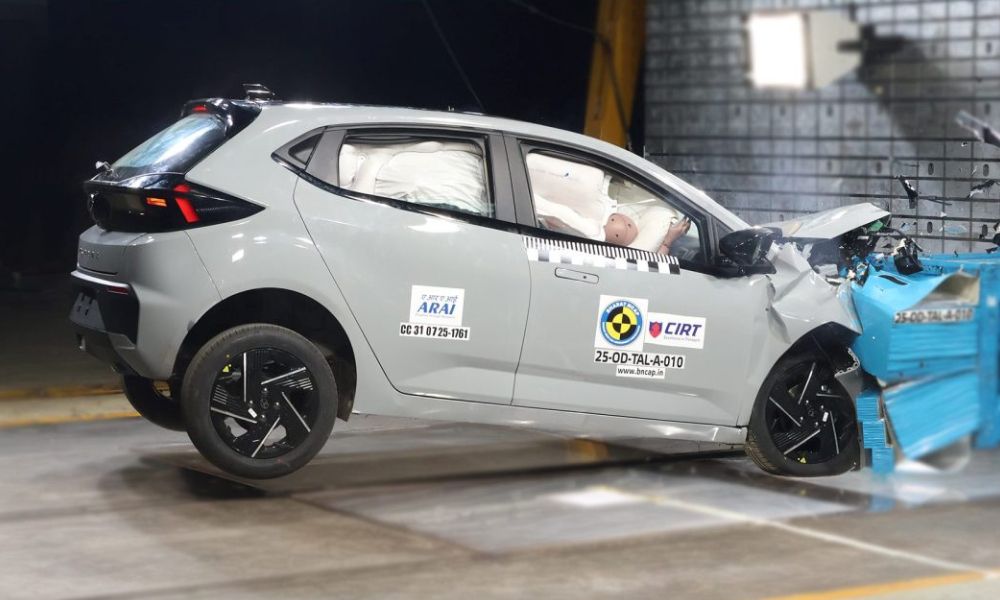Thanks to the powerful engine, the Basalt AT is a competent highway performer too. It can easily hit triple-digit speeds.
Driving the Citroen Basalt 1.2L Turbo-Petrol AT
1.2L turbo-petrol engine makes 109 BHP @ 5,500 rpm and 205 Nm @ 1,750-2,500 rpm:

The Basalt is powered by a 1.2L turbo-petrol engine that belongs to Citroen’s EB family of engines. This 3-cylinder unit is mated to a 6-speed torque converter automatic transmission and puts out 109 BHP and 205 Nm (15 Nm more than the MT).
Release the brake and the Basalt AT moves off the line without any drama. The throttle response is good too. The Aisin-sourced 6-speed automatic transmission is smooth and compliments the engine well. It masks any sign of turbo lag nicely. The car moves off seamlessly from a standstill. Once you’re moving, light accelerator input is all you’ll need to commute in the city. The gearbox shifts up early and smoothly. Driving with a light foot or even medium throttle, you’ll never even know that the gears are being changed. It’s only the change of pitch in the engine noise that indicates a change of gear. The gearbox is in the right gear most of the time and is never confused. The turbo-petrol offers brisk acceleration, with the power & torque on offer making the gearbox’s job easier. Closing a gap to the vehicle in front is easy. For bumper-to-bumper traffic conditions, there is a fair amount of ‘crawl’ available too. Just lift your foot off the brake pedal in ‘D’ and the Basalt will crawl forward at 7 km/h, allowing you to drive in thick traffic with just one pedal (the brake). The powerful turbo-petrol engine, combined with the smooth AT, light steering, good ergonomics, useable dead pedal & clear frontal visibility makes the Basalt AT easy to drive in the city.
Thanks to the powerful engine, the Basalt AT is a competent highway performer too. It can easily hit triple-digit speeds. Thanks to the strong mid-range, overtaking is not a problem either. However, kickdown response time is slow. If the revs are on the lower side, and you floor the accelerator, it takes well over two seconds for the gearbox + turbo to react. Since the transmission tends to shift up early, this can happen frequently. The problem can be solved by being less aggressive with the throttle. The gearbox is quite responsive to medium throttle inputs and once the AT & turbo respond, the car is very peppy. When the engine is in the meat of the powerband, the reaction times are lesser. In terms of cruisability, the Basalt can do 100 km/h with the engine spinning at ~1,850 rpm.
Manual mode is useful when you want to prepare the car for overtaking a fast vehicle on a 2-lane highway, or when you desire engine braking. Move the gear lever to the left to engage manual mode. The response time to your commands is quick. That said, there is a slight lag between the gear actually shifting and the change being reflected on the MID. What we found disappointing was that, even in manual mode, you can take the revs to just ~5,800 rpm (which is way short of the start of the redline i.e. 6,500 rpm) before the transmission shifts up on its own. Also, keep in mind that it’s tuned very conservatively & won’t allow aggressive downshifts if the rpm level is higher than ~3,200 rpm. We would have also liked to see paddle shifters here.
Noise, Vibration & Harshness (NVH)
There is a slight body shake on cranking the engine. At idle, the turbo petrol is surprisingly silent, and the typical 3-cylinder vibrations are masked quite well. However, you will feel some vibrations on the steering and through the seat. There’s not much noise and the cabin is silent. While driving around calmly, the engine sound doesn’t intrude into the cabin. However, rev the engine and you’ll hear it a lot more inside the cabin. Unfortunately, the engine note is not something enthusiasts or regular folk will like. It sounds more strained than sporty at high revs. At highway speeds, wind noise is kept at a minimum, but road noise and tyre noise do creep into the cabin.
Mileage & Fuel economy
As we are already aware, turbo-petrols are sensitive to throttle input and you will be visiting the fuel station more often if you have a heavy foot. But drive sedately and you should see some acceptable FE figures. The Basalt turbo-petrol AT’s ARAI-certified fuel efficiency is 18.7 km/l. The car gets an auto start-stop feature which should help fuel efficiency while driving in the city. The system in our test car was erratic and didn’t work until the latter part of the drive. When it did though, it functioned seamlessly and was not as intrusive as we have seen in some other cars.
The turbo-petrol MT has an ARAI-certified fuel efficiency of 19.5 km/l, while the NA petrol’s FE is rated at 18 km/l.
Suspension

Ride Comfort
The Basalt comes with a McPherson strut suspension at the front and a twist-beam suspension with coil springs at the rear. Right off the bat, this is a very likeable suspension tune. Just like the C3 Aircross, the setup is very compliant. The ride over small potholes and uneven roads in the city is excellent. The Basalt dissipates shocks very evenly over the front and rear which gives you a feeling of gliding over bad roads. The car remains stable and maintains its composure well. Moreover, the suspension works silently too when going over bumps. Large potholes do register themselves in the cabin, but the Basalt handles them well. Overall, the ride quality is very absorbent.
Handling & Dynamics
The French sure know a thing or two about tuning the suspension just right. Straight-line stability is good and the passengers probably won’t even know that you’re cruising at triple digit speeds.
The Basalt is a good handler. It holds its line nicely in long curves. There is some amount of body roll, but it never gets excessive. Hit an unexpected expansion joint on the curve and the car doesn’t get unsettled easily. Start pushing on twisty roads and you will appreciate the balance of the chassis. The turn-in is sharp and there is a hint of understeer. With the turbo-petrol under the hood, you can really enjoy the car with this suspension. Changing directions from one corner to the other also doesn’t unsettle it and the transition is smooth. The 205/60 R16 OEM tyres feel just about adequate for and provide fair grip levels.
Steering
The Basalt’s electric power steering is a very user-friendly unit. It’s light in the city and most owners will appreciate that. While driving, the car masks its dimensions well and feels compact. The steering weighs up nicely as you gain speed. However, enthusiasts won’t like the disconnected feeling of the steering and the vagueness in the centre.
Braking
The Basalt is equipped with ventilated disc brakes at the front and drum brakes at the rear. The performance is as expected and the car comes to a halt without much drama. The pedal feel is very progressive and smooth.
Continue reading the discussion on the Citroen Basalt on our forum.






